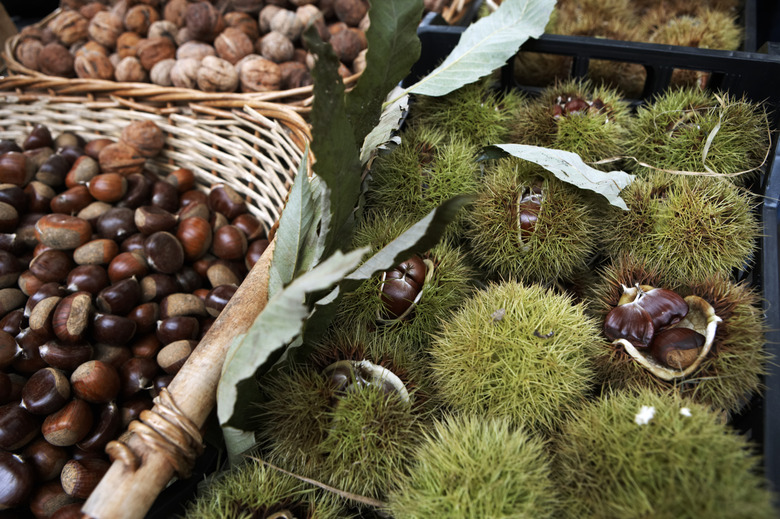What Type Of Tree Has Green Balls?
Some trees can be curiosities, producing fruit that is unusual enough to draw attention. A number of trees produce large, green, round fruits that may be attractive or just strange and attention-grabbing. For those who have trees like these located in their landscapes, these fruits may be a mixed blessing. While providing a pleasant shady environment, these trees may litter the yard with dropped fruit.
Osage Orange Trees
The Osage orange (Maclura pomifera), hardy in U.S. Department of Agriculture plant hardiness zones 4 through 9, isn't actually an orange, but the fruit resembles oranges in size and skin texture. The trees are large and can reach 60 feet with great age. It isn't a friendly tree, because it not only produces thorns but female trees bear heavy, 3- to 5-inch-wide fruits that litter landscapes and are difficult to clean up. The milky sap can sometimes cause allergic reactions on the skin. However, the fruits are interesting and are sometimes used as temporary decorations in fruit bowl displays.
- Some trees can be curiosities, producing fruit that is unusual enough to draw attention.
- It isn't a friendly tree, because it not only produces thorns but female trees bear heavy, 3- to 5-inch-wide fruits that litter landscapes and are difficult to clean up.
Walnut Trees
Both English (Juglans regia) and black walnuts (Juglans nigra), hardy in USDA zones 5 through 9, produce heavy green round-to-oval fruits. Most people don't choose walnuts as a landscape tree, but they are occasionally found as remnants of orchards or as chance seedlings that grew untended. Although walnuts are very large trees and produce great shade, the green fruits are messy, difficult to clean up and often stain cement, hands or other items. Other plants don't grow well under walnuts due to chemicals emitted by the roots and litter.
London Plane and American Sycamore Trees
London plane (Platanus x acerifolia), hardy in USDA zones 3 through 10, and American sycamore (Platanus occidentalis), hardy in USDA zones 4 through 9, are from the same genus and therefore bear similar fruits and habits. They are popular, large shade trees with maple-like leaves. Each bears spiky green fruits that age to brown when mature. These ball-shaped fruits are about 1 inch across and break apart when mature, dispersing silky seeds.
- Both English (Juglans regia) and black walnuts (Juglans nigra), hardy in USDA zones 5 through 9, produce heavy green round-to-oval fruits.
Chestnut Trees
Chestnuts are large trees that are used ornamentally or for food production. Each produces spiky green fruits that crack open to reveal shiny nuts about 2 inches across. However similar they may seem, the fruit from the horse chestnut (Aesculus hippocastanum), hardy in USDA zones 3 through 8, is not edible, while the edible chestnut (Castanea spp.), hardy in USDA zones 3 through 11, is considered a delicious treat. The edible chestnuts have green husks covered in spiny, needle-like protrusions, while the inedible chestnuts bear husks with sharp, warty protrusions that do not cover the entire surface of the husk. Chestnut trees make great shade trees and produce pretty flowers but can be a hazard due to the potential for being struck by or stepping on the spiky fruits.
References
- Missouri Botanical Garden: Maclura Pomifera
- Pollen Library: Osage-Orange (Maclura)
- Forest Service Department of Agriculture: Juglans Nigra
- University of Idaho: Carpathian Walnut
- Landscape Architecture Blog: Plant of the Week: Platanus x Acerifolia
- Forest Service Department of Agriculture: Platanus Occidentalis
- Landscape Architecture Blog: Plant of the Week: Castanea sativa
- Chestnutz: Chestnuts Worldwide and in New Zealand
